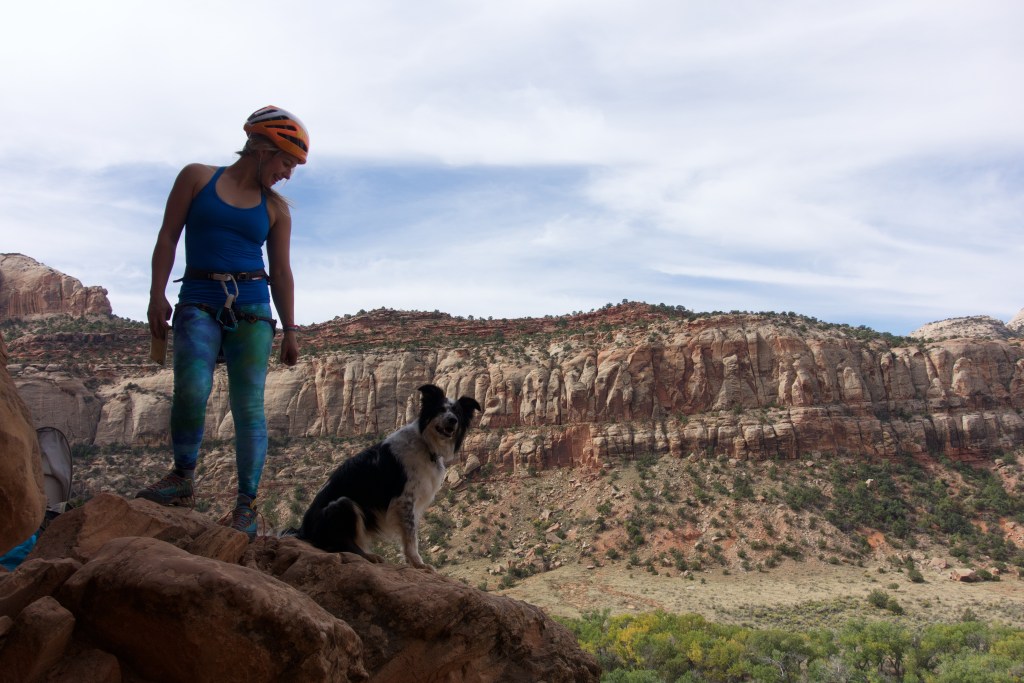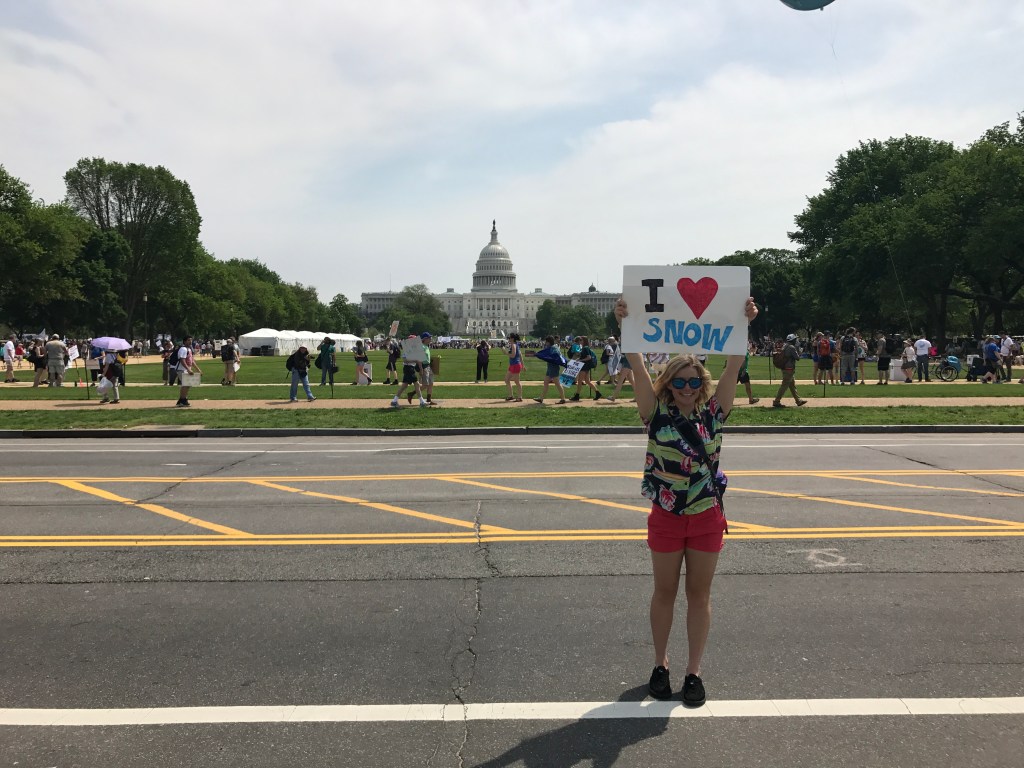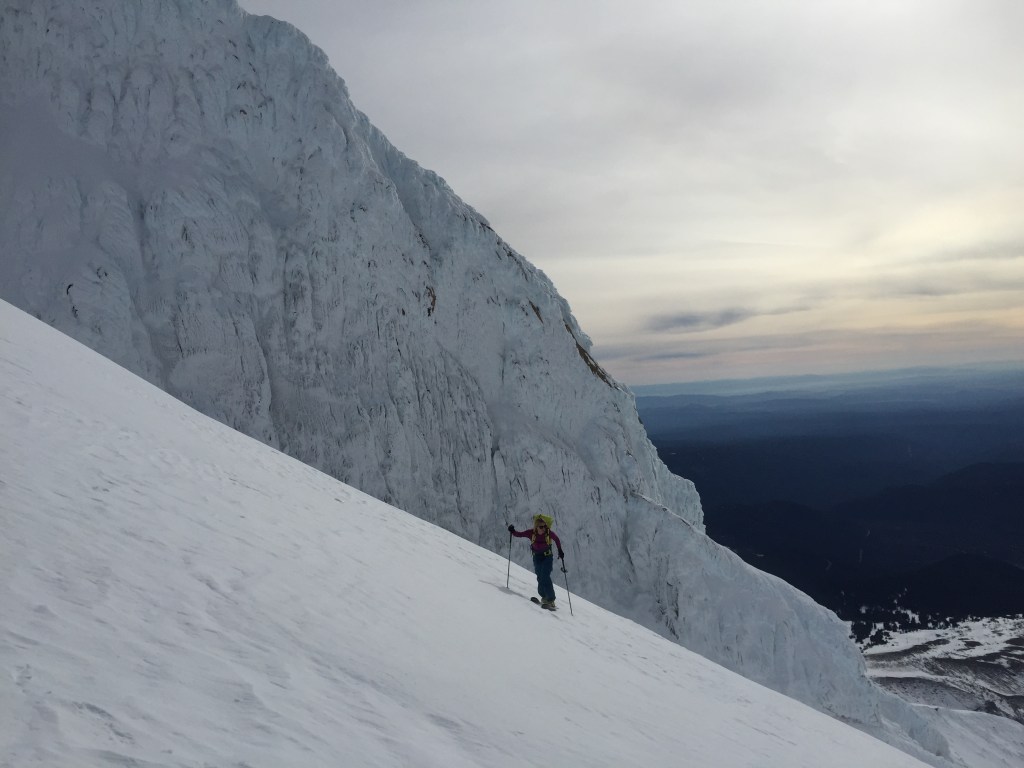At first, it can seem overwhelming to get involved and advocate for a cause. Professional ski mountaineer and environmental activist Caroline Gleich shares what motivates her.
It was July 2016 in the desert of southeastern Utah, and the temperature was almost 100 degrees by 9 a.m. as I parked my car on the side of a dusty road near the Bluff Community Center. I was attending a public meeting organized by then Secretary of the Interior Sally Jewell about the future of Bears Ears. I was more than two hours early and the crowd was already starting to overwhelm the tiny community center. The pro- and anti-monument tension was rising as quickly as the temperature.
I was grateful to have my friends at my side. I discovered this event through the Utah Dine Bikeyah, a coalition of five Native American Tribes who were leading the fight to permanently protect Bears Ears through monument designation, and I stopped by their tent on my way to get in line to grab a blue “Protect Bears Ears” t-shirt.
We waited outside for two hours in the increasing heat before the doors to the building opened, and I grabbed a ticket for a lottery to speak. There was standing room only—it only got hotter and stuffier inside. It was a powerful relief to look around and see a sea of light blue t-shirts showing support for the monument. As the meeting started, the organizers drew numbers from the lottery and each speaker received two minutes.
After listening for three hours, my number was finally called. My heart pounded as I approached the podium. My voice quivered as I began to talk about my experience in the area and why it should be protected as a monument. It was scarier than dropping into a steep ski line or leading a hard pitch. Halfway through, the moderator had to stop me to tell the crowd to be quiet because people were yelling so loudly, booing and telling me to go home. Walking back to my car after the event, I was still scared and felt physically and emotionally drained. But I knew one thing for certain: The huge turnout of people made an impact.
In December, I received an email from the White House. It told me that Bears Ears would be designated as a national monument and asked me if I wanted to share an Instagram post on their account about it. I almost cried with happiness. It was one of the most gratifying experiences of my life. I had an opportunity to put everything I had learned about affecting public policy into action. And the most important take home lesson? No matter how difficult it is, we need to continue to show up for the causes we believe in.
Fast forward to April 2017, when an executive order called for the review of 27 national monuments, including Bears Ears. After a lengthy public comment period, the future of many of these public lands remains uncertain. But it will depend, more than ever, on input from people like you.

Caroline Gleich on a climbing trip to the Bears Ears area. Photo Credit: Rob Lea
I was first introduced to how I could be a force for change during college at the University of Utah. As I was approaching graduation, I had to take a mandatory American National Government class. When I walked into class, I was instantly captivated by my teacher, Professor Tim Chambless. The questions he posed still stick with me today: How do you want to interact with government? Do you want your only interactions with government to be when the police pull you over for speeding or when you pay your taxes? Or do you want to be proactive and come to the table as informed citizens, actively sharing concerns and participating in the decision making process?

Photo Credit: Rob Lea
In that course, I learned government is a tool for problem solving. Our democracy is still in evolution and how it advances will be determined by people like you and me. I knew I wanted to work in environmental policy, so shortly after that course, I took an internship with Ted Wilson, the former mayor of Salt Lake City and a rock and ice climber with multiple first ascents under his belt. I spent the summer assisting him in his new role as the environmental adviser to Utah Governor Gary Herbert. Ted was incredible in the way he could get folks from different points of view together to sit down at the table, look one another in the eye and try to find common ground.
Working with Ted, I noticed how a climber’s mindset could be applied to politics and government. As climbers, we are dreamers who believe we can accomplish what others call impossible. To us, a mountain isn’t impassable. It’s a challenge, and we greet the hardest challenges with an enthusiastic smile. It’s similar to picking a goal in the mountains: When you support a cause, you must have the courage and tenacity to follow up on your intention with action.
For example, experiencing Utah’s poor air quality made me want to become an activist for clean air. I researched the issue and found out about the HEAL Utah, a local nonprofit organization devoted to promoting a healthy environment in Utah. They are champions of clean air and clean energy, and aim to protect Utahns from the toxic effects of dirty energy. I signed up for their email alerts and started attending their events to get more involved. I went to lobby trainings, fundraisers and rallies. I invited my friends and family to get involved to grow their message and work.

Photo Credit: Rob Lea
As a professional skier, I’ve seen firsthand the effects of climate change on winter in Utah and around the world. Shrinking glaciers have made ski mountaineering more difficult and dangerous, and I felt compelled to speak up about climate change. In 2011, through Protect Our Winters, I started participating in the Hot Planet/Cool Athletes program, where athletes visit high schools and middle schools, educating thousands of students about the science of climate change and sharing stories about our love of the outdoors. We follow up with practical tips to inspire them to take leadership in their schools and communities, and become catalysts for change.
As an outdoor community, we derive so much joy from our experiences with nature. What if, instead of only focusing on chasing powder, sending our project or searching out the best singletrack, we asked how we can give back to the places in which we love to play? Imagine if everyone donated a small fraction of the time they spent outdoors to protecting and improving the outdoor experience for future generations.
How to Get Involved
Think about how you interact with nature and the outdoors. Ask questions and follow up to find out the answers. Who manages the local trails you hike? Where does the funding come from? Who built these trails? How did this land get protected? Make sure you understand Leave No Trace Principals. And start learning about the various local, state and federal land management agencies.
Get involved with local, grassroots environmental nonprofits. They are an incredible resource for getting informed and involved. Check out SHIFT’s interactive map of individuals, organizations or initiatives that leverage outdoor recreation for conservation gains. You could also find a local chapter of the Sierra Club or learn more about the work of the Wilderness Society.
Use your sport as a catalyst for change. Join together with fellow outdoor enthusiasts and give back to the places we play. Plus, it’s way more fun if you bring a friend or two along. Call up your buddies and get them to come with you. Here are a few organizations I work with: American Alpine Club, Access Fund, Protect Our Winters and Winter Wildlands Alliance.
Devote a day to give back. Be of service to your community. Find ways to raise awareness whether marching for a cause you believe in or attending a town hall meeting. Show up to a town hall or public hearing prepared with questions or a statement. Have a sign making party. Another way to support your community is through a stewardship activity.
Read and listen to the news. Learn by paying attention to what is happening at local, national and international levels. When possible, go beyond your typical news sources and read more in-depth coverage, taking the time to understand different positions on an issue. It’s impossible to know everything about every issue. To be an effective activist, I believe it is important to focus on a few key issues and learn the ins and outs of those. I pay close attention to local newspapers and read the details of the email newsletters from the local nonprofits I work with. Another good spot for researching political issues is the Pew Research Center.
Know who your elected officials are. Follow them on social media and sign up for their email alerts and mailing lists so you can stay in the know about town halls and other opportunities. Here’s how to figure out who your elected leaders are and how to get in touch with them.
Don’t rely on phone calls or emails to your elected officials. Show up in person, prepare a speech and practice it beforehand. Contact your elected officials before the legislative session starts and ask for 10 minutes of their time. Make sure to follow up and be persistent. Be focused on one or two issues.
We’re lucky to have the freedom to use the outdoors as a playground and an escape from the burdens of daily life. It’s one thing to care or to post about something on social media. It’s another to show up and do the hard work. While creating awareness about an issue is a good first step, it’s important to follow through with an action plan that takes you outside the digital realm. With freedom comes responsibility. Step up and take your role as an active citizen seriously.


